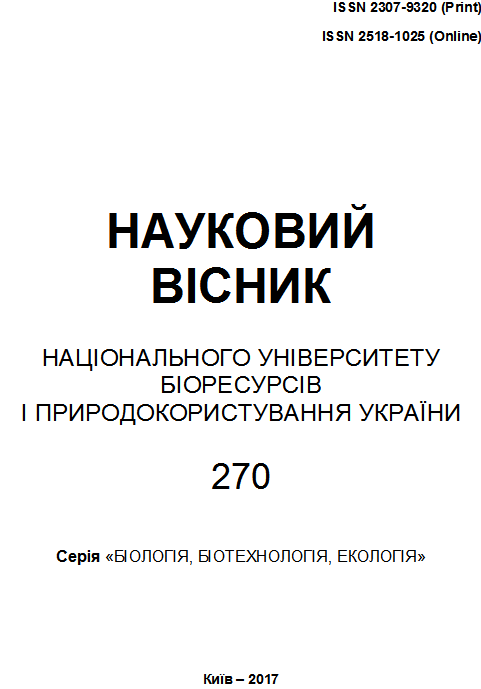ENVIRONMENTAL EVALUATION OF THE MODERN CONDITION OF WETLANDS OF IRPIN’ RIVER FLOODPLAIN: APPROBATION OF AMERICAN EXPERIENCE
Abstract
In the article the ecological state of the wetlands of Irpin’ River floodplain was analyzed.The assessment is based on a complex of criteria with use a large quantity of indexes of vegetation, landscape, hydrology, water quality and soil quality. It has been established that the current state of these wetlands is good with a weak deviation from the basic characteristics. Predominantly, wetlands are functioning within the limits of natural regimes. The surrounding landscape is minimally fragmented and contains mostly natural components. The composition and structure of plant groupings are slightly beyond the natural range of variation. There are a small number of weeds and aggressive plant species. There are many key species for wetland species. Soil properties and hydrological conditions were changed not significantly.Besides, there are stress factors in wetlands such as: unpaved roads, buildings grazing, places of recreation or human visitation, recent old fields with plowing or disking, drainage channels, deep pits, dumping garbage or waste.
The results of the assessment are objectively reflecting the actual state of this ecosystem. The Ecological Integrity Assessment (EIA), which we have tested, can be used for the objective characterization of the ecological integrity, functional state and functional capabilities of the wetland ecosystems of the Right Bank Forest Zone of Ukraine.
Keywords: wetlands, Irpin’ river basin, floodplain, ecological status, vegetation, landscape, water, soil, groundwater level, stress factors.
References
Marushevsʹky H. B., Zharuk I. S. (pid red.) (2006). Vodno-bolotni uhiddya Ukrayiny. Dovidnyk [Wetlands of Ukraine. Handbook]. Kyiv, 312.
Klimov O.V., Klimov D.O., Haydrikh I.M. (2014). Vodno-bolotni uhiddya ta klasyfikatsiya ekolohichnykh system Ukrayiny [Wetlands and classification of ecological systems in Ukraine]. Problems of environmental protection and ecological safety, 36, 67-82. Available at: http://irbis-nbuv.gov.ua/cgi-bin/irbis_nbuv/..../Ponp_2014_36_8.pdf.
Malʹtsev V.I., Zub L.M., Karpova H.O., Kostyushyn V.A., Tytar V.M., Mishta A.V., Nekrasova O.D. (2010). Vodno-bolotni uhiddya Dniprovsʹkoho ekolohichnoho korydoru [Wetlands of the Dnipro Ecological Corridor]. Kyiv: Non-governmental scientific institution INECO Institute of Ecology, Karadag Nature Reserve of the National Academy of Sciences of Ukraine, 142.
Yu.P. Fedotov (pid red) (2010). Transkordonni vodno-bolotni uhiddya Rosiyi ta Ukrayiny v dolynakh richok Desna i Snov [Transboundary wetlands of Russia and Ukraine in the valleys of the Desna and Snov rivers]. Bryansk, 84.
Trubizh Wikipedia, the free encyclopedia (reference date 15.10.2017) [Electronic resource]. - Access mode: //uk.wikipedia.org/wiki/ (reference date 15.10.2017). - (Name from the screen).
Frolova H. V. (2010) Ponyattya vodno-bolotnykh uhidʹ ta yikh klasyfikatsiya [Concepts of wetlands and their classification]. Actual problems of state and law. 52, 227-234. - Available at: http://nbuv.gov.ua/UJRN/apdp_2010_52_39.
Frolova N.V. (2009). Pravova okhorona vodno-bolotnykh uhidʹ vid antropohennoho vplyvu [Legal protection of wetlands from anthropogenic impact]. Actual problems of state and law. 46, 272-276. – Available at: http://www.apdp.in.ua/v46/47.pdf.
Joanna Lemly, Laurie Gilligan (2013). Ecological Integrity Assesment (EIA) for Colorado Wetlands Field Manual, Version 1.0 – REVIEW DRAFT, 92. Available at: http://www.cnhp.colostate.edu/download/documents/ 2013/2013_Colorado_EIA_Field_Manual_-_Verion_1.0_REVIEW_DRAFT. pdf.
Methods for Evaluating Wetland Condition: Wetlands Classification. Office of Water (2002). U.S. Environmental Protection Agency, Washington, DC., EPA-822-R-02-017, 36. Available at: https://www.epa.gov/sites/ production/files/documents/ wetlands_7classification.pdf
Scott Frazie (1999). Ramsar Sites Overview. A Synopsis of the World’s Wetlands of International Importance. Wageningen: Wetlands International, 42.
Downloads
Published
Issue
Section
License
Relationship between right holders and users shall be governed by the terms of the license Creative Commons Attribution – non-commercial – Distribution On Same Conditions 4.0 international (CC BY-NC-SA 4.0):https://creativecommons.org/licenses/by-nc-sa/4.0/deed.uk
Authors who publish with this journal agree to the following terms:
- Authors retain copyright and grant the journal right of first publication with the work simultaneously licensed under a Creative Commons Attribution License that allows others to share the work with an acknowledgement of the work's authorship and initial publication in this journal.
- Authors are able to enter into separate, additional contractual arrangements for the non-exclusive distribution of the journal's published version of the work (e.g., post it to an institutional repository or publish it in a book), with an acknowledgement of its initial publication in this journal.
- Authors are permitted and encouraged to post their work online (e.g., in institutional repositories or on their website) prior to and during the submission process, as it can lead to productive exchanges, as well as earlier and greater citation of published work (See The Effect of Open Access).

